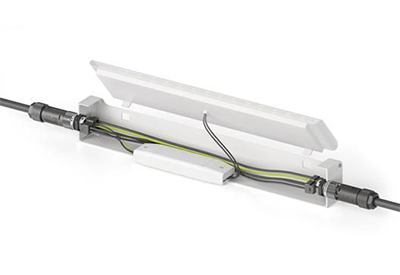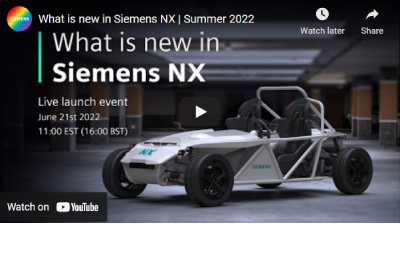Inspection Capabilities Skyrocket Using Innerspec Test System
August 15, 2024
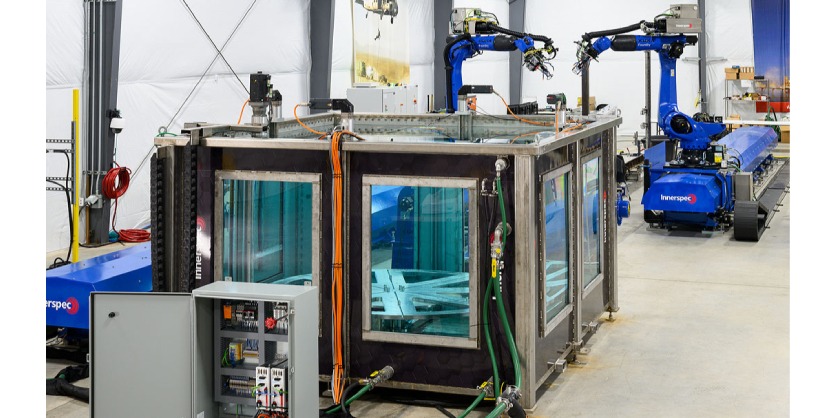
PC-based control and EtherCAT from Beckhoff power the Twin Robotic NDT System while boosting aerospace inspection speeds by a factor of 10
Designing non-destructive test (NDT) systems for aerospace clients can feel like engineering with blindfolds on. Even when the parts under test aren’t confidential, they can change rapidly as companies optimize their designs. This accelerated innovation helps launch more powerful, safer vehicles for use inside Earth’s orbit and beyond. But how do you create precision inspection systems without knowing what they’ll inspect in the field?
Innerspec Technologies understands how to tackle this challenge and proved it when designing an advanced NDT machine for a major aerospace customer. The Twin Robotic NDT System leverages two robot arms, plus a tank and turntable to fully submerge parts. This offers wide-ranging testing options as parts evolve with simplified tool changes.
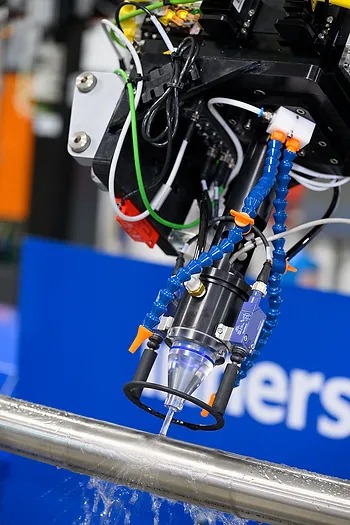
“The type of inspection is dictated by part geometry, material composition and the defects it needs to find,” says Cory Grant, Director of Systems Engineering at Innerspec. “We may receive a small volume of samples for the acceptance test, but we have to design machines for the huge variety of parts we’ll never see. So we work around the unknown parameters and make the machine as universal as possible.”
Innerspec has maintained its reputation as a pioneer in NDT systems since its founding in 1989. Based in Forest, Virginia, the company’s engineers design custom systems for major players in aerospace, transportation, energy and beyond. In 2018, Innerspec entered the field of robotic NDT and has quickly become one of the main suppliers in the North American market.
Through research and innovation, Innerspec develops exciting solutions that are often the first of their kind. It commercialized Electromagnetic Acoustic Transducer (EMAT) technology, which generates soundwaves inside the part and doesn’t require liquid ultrasonic couplant, and recently released the portable VOLTA 2 system using the technology. The company supports numerous inspection types, such as Ultrasonic Testing (UT), Eddy current and Phased Array Ultrasonic Transduction (PAUT), to ensure customers aren’t limited in their options.
So Innerspec relies on open, scalable technology from Beckhoff Automation to boost flexibility. “Beckhoff’s approach to automation technology resonates with us,” Grant says. “They give you open, flexible tools with solid documentation and let you mold the products to fit your application.”
Remove all test limitations before flight
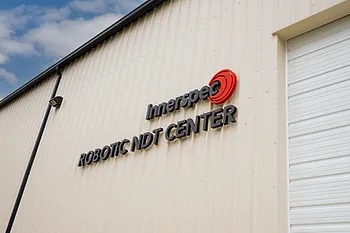
The Robotic Twin system developed by Innerspec includes a total of 18 coordinated axes of motion and includes two robots mounted on tracks, a turntable for Eddy Current inspections, a linear rotator and a 5,000-gallon tank for ultrasonic testing with an immersed turntable capable of handling components weighing up to 3,000 pounds.
Innerspec strives to provide superior inspection capabilities, but the engineers must also simplify operation, maintenance and end user programming for new parts. The automation components needed to share test data seamlessly with an industrial server and two third-party PCs – one for acquiring and safely storing data, another for manual analysis by a trained specialist.
“No matter the type of aerospace vehicle a part is designed for, a qualified expert needs to sign off on it, saying that part is ready for flight,” explains Joseph Ziedas, Project Engineer at Innerspec. “All those computers and our machine controller communicate with each other using OPC UA and MQTT.”
The Innerspec team is steeped in software development experience. But with previous controls platforms, integration of automation and IT standards proved difficult. Grant wanted to increase collaboration between the controls and software engineers by switching to a new automation platform.
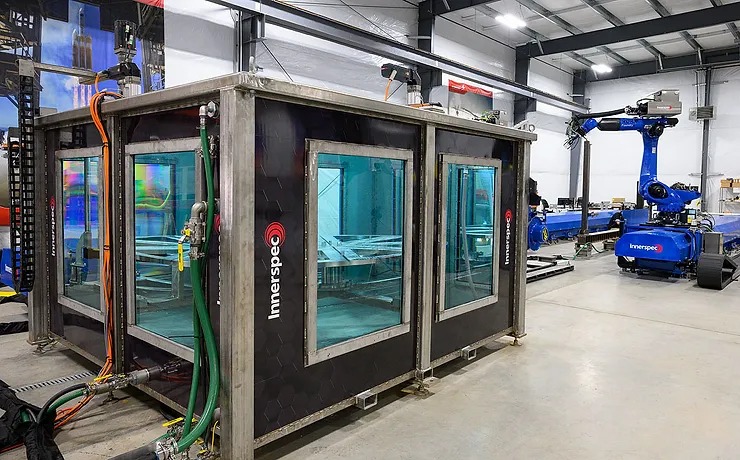
His first experience in building NDT systems was with a systems integrator. There, he saw how EtherCAT and PC-based control technology from Beckhoff provided an incredibly powerful and flexible platform for test and measurement applications. After joining Innerspec in 2021, he worked with the in-house engineering team to begin migrating to Beckhoff to solve a variety of challenges.
“Back in 2015, I started searching for systems that were more flexible and incorporated software development principles, version control, Structured Text and object-oriented programming. Working with Beckhoff continues to be a major advantage in these areas,” he says. “With TwinCAT 3 automation software, I can be involved in anything from HMI design to PLC development.”
Innerspec launches an automation software inspection

The Twin Robotic NDT System was the first complete Beckhoff solution from Innerspec, and it needed to perform flawlessly in such a high stakes project. Working closely with the local engineering experts from Beckhoff USA – Sales Engineer Rodney Reid and Applications Engineer Jack Plyler – Grant moved ahead with the platform migration.
The key to enhancing the NDT system’s capabilities and flexibility was TwinCAT. Beyond streamlining PLC and PTP motion control, the software provides an end-to-end engineering and runtime environments for all aspects of automation.
“TwinCAT is integrated into Microsoft Visual Studio®, so it empowers our engineers to program in the languages that best fit the application,” Reid explains. “These include IEC 61131-3 languages with their object-oriented extensions, predefined or custom function blocks, and computer science standards from C# and C++ to Python.”
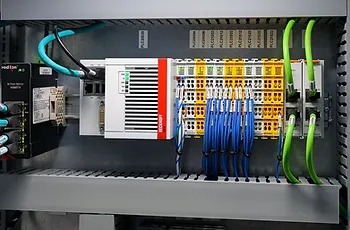
Grant took advantage of this when working with Innerspec’s software development team. Together, they built the machine’s operator interface in TwinCAT HMI, which supports modern UX creation using web-design standards like HTML5, JavaScript and more.
Innerspec’s Robotic Twin system also benefited from the TwinCAT XML Server. This function provides a PLC library that enables write/read access for XML data.
“Anytime I’m working on the PLC and start typing in a number, I stop and make it a variable. Then it goes into the XML file that can be accessed via the TwinCAT XML Server,” Grant says. “I can add all the configuration settings to the XML file. So whether the customer is setting up for a new part or conducting maintenance, the TwinCAT XML Server increases extensibility, transparency and control.”
NDT mission control with PC-based automation
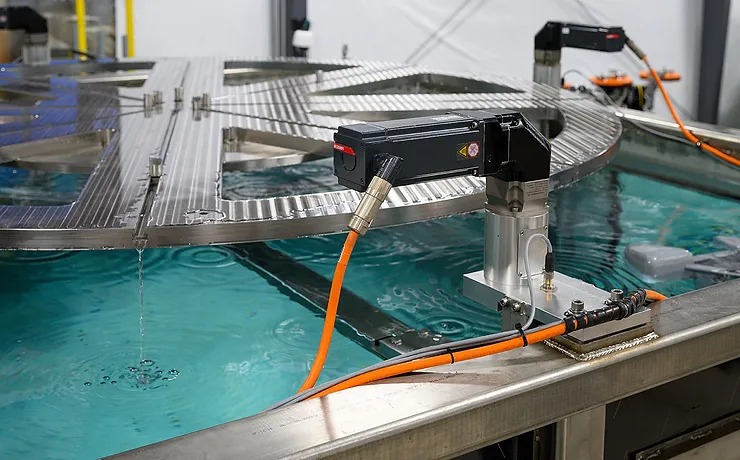
A Beckhoff CX5130 Embedded PC serves as the machine controller for the entire system. Via directly connected EtherCAT Terminals, the CX5130 acquires data from various sensors on end-of-arm tooling and sends it to the system’s server and analysis PCs using OPC UA and MQTT functionality in TwinCAT IoT. The multi-core machine controller’s fast cycle times support precision motion from the four Beckhoff servo axes, 16 third-party motors and two KUKA robot controllers.
One AM8000 servomotor with One Cable Technology (OCT) from Beckhoff sits atop each side of the tank. The four servos rotate with perfect synchronization to raise and lower the turntable using waterproof ball screws.
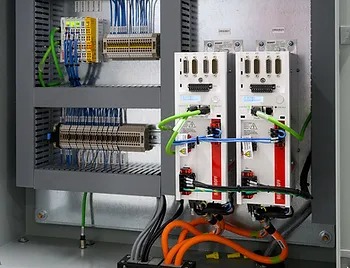
With TwinCAT Motion Designer 2, Grant was able to not only precisely size servomotors for the application, but also understand why his first selection of ball screws wouldn’t work for the application so he could select a more appropriate mechanical solution. The result is a powerful system that enables submerged inspection of parts measuring up to 100 inches in diameter and weighing 2,500 pounds.
“As the turntable raises and lowers, TwinCAT libraries for software-based gearing perfectly sync the motors,” Grant says. “When the turntable nears the bottom of the tank, the servo system switches from a position-based mode to a torque-based mode. By turning the motors to a specific torque, we push the frame into the floor of the tank up against wedge hard stops, which lock it in place. That way, giant parts remain stable even when they’re spinning at 30 rpm.”
Two dual-channel AX5206 Servo Drives power all four motors. They also directly integrate motion safety in the drive components via TwinSAFE. Using Safety over EtherCAT (FSoE) technology, the drives feature on-board STO, SS1 and SS2.
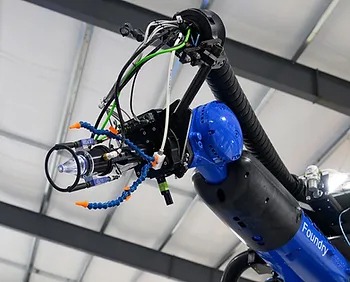
“Innerspec is really taking full advantage of the Beckhoff servo technology,” Beckhoff’s Plyler says. “The functionality Cory is implementing – from switching between position and torque control to leveraging built-in safety – is unique. It shows his depth of knowledge with Beckhoff technologies and systems engineering in general.”
The EtherCAT industrial Ethernet system enables real-time communication and tight synchronization among the motion axes. In addition, combining power and communication via OCT helped to reduce wiring time and costs on the 120-foot-long system. Innerspec also found it easier to implement the robots and third-party drives since KUKA supports the EtherCAT standard.
RELATED: Voxel’s robot-equipped production line for electrochemical machining
“Native support for EtherCAT removed any communication barriers with the robots and made it easier to swap our end-of-arm tooling on the fly. Here, EtherCAT’s Hot Connect capabilities help us accommodate different inspection types,” Ziedas says. “And built-in FSoE streamlined safety for the robotics and across the system, whenever we add light curtains, safety scanners, gate switches or e-stops. That complete integration makes the overall system so much more powerful.”
NDT tech lifts off using New Automation Technology
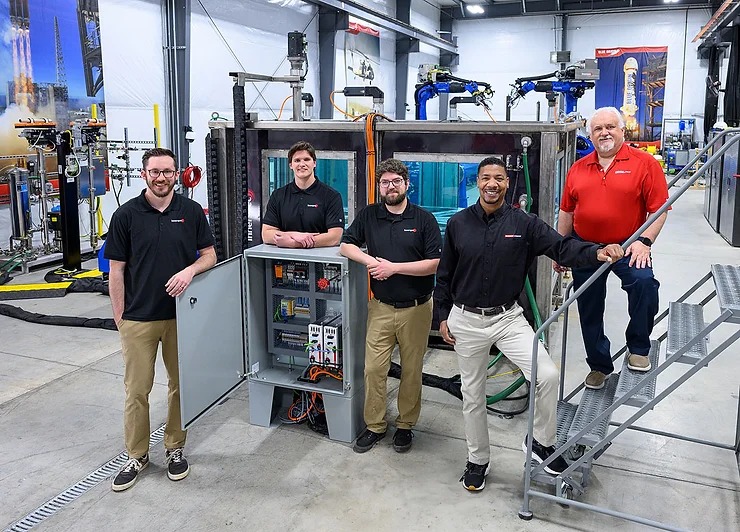
“Native support for EtherCAT removed any communication barriers with the robots and made it easier to swap our end-of-arm tooling on the fly. Here, EtherCAT’s Hot Connect capabilities help us accommodate different inspection types,” Ziedas says. “And built-in FSoE streamlined safety for the robotics and across the system, whenever we add light curtains, safety scanners, gate switches or e-stops. That complete integration makes the overall system so much more powerful.”
NDT tech lifts off using New Automation Technology
Harnessing the powerful tools, Innerspec met all the otherworldly technical requirements for their major aerospace customer. The Twin Robotic NDT System retains peak flexibility to accommodate new parts or processes in the future.
The transition to Beckhoff technologies helped ensure greater performance. For example, Grant can write custom C++ code and deploy it via a TwinCAT function rather than use the robot controllers’ base functionality for triggering tools.
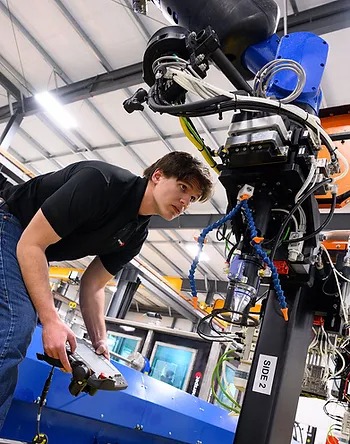
“With KUKA’s Fast Send Driver, you can go down to 1 millisecond per update, but with our software algorithms implemented in the C++ module in TwinCAT, we can do it in about 100 microseconds,” Grant says. “So we can basically trigger instruments 10 times faster than we were able to previously, which dramatically increases inspection speeds and accuracy.”
For Grant, the advantages of PC-based automation from Beckhoff are less about crunching numbers than creating entirely new possibilities in the field. “Overall, the main benefit of Beckhoff is the customer-friendly approach to controls. The technology is open, makes it easy to use object-oriented programming in Structured Text and integrates everything from PLC, motion and safety to HMI, measurement and more in one software environment,” he says.
EtherCAT’s robust diagnostics, Distributed Clocks for synchronization and free selection of network topology were also game changers, Grant explains: “Plus, the sheer number of I/O terminals from Beckhoff – everything from the EL2124 5-volt output cards to EL6224 IO-Link gateways – guarantee we can easily adapt to fulfill customer requests and connect with any device that comes our way.”
The technology also enhanced operator interaction through TwinCAT HMI – with a built-in view of the EtherCAT diagnostics – and TwinCAT XML Server, Grant explains: “Two of my goals when building systems are, one, to make the machine operators happy and, two, to make the maintenance personnel happy. On the Robotic Twin, we know the operators love the look, feel and interface on the machine, along with its reliable performance and flexibility.”
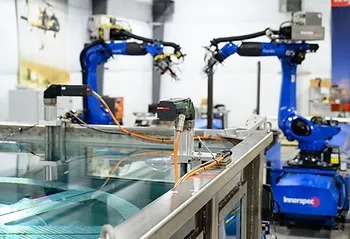
Innerspec delivers impressive results through tight integration between systems. By creating powerful, purpose-built NDT solutions, rather than combining disparate pieces of machinery, the inspection experts provide more dynamic tools for customers across industries. So even if the critical parts are top secret, or not even invented yet, the NDT technology can adapt to evolving needs.
“Our seamless integration translates into a more uniform and fluid experience for the user. It can be as simple as consistent branding and themes or as complex as uniform data acquisition and transmission,” Grant says. “When you’re able to control all the pieces in your system, you make higher-quality products in the end despite any unknowns.”
Ready to future-proof your machines with scalable, compact control and motion technologies? Contact your local Beckhoff sales engineer today.
Related Story
Beckhoff’s TwinCAT Automation Software
When Beckhoff launched its PC-based control technology, it created a global standard for automation. In terms of software, the core of the control system has taken the form of The Windows Control and Automation Technology – or TwinCAT – automation suite since 1996. In combination with TwinCAT, the Beckhoff portfolio results in optimally coordinated automation concepts that fulfill the basic principles of an open and highly scalable control system.
TwinCAT transforms almost any PC-based system into a real-time control complete with multiple PLC, NC, CNC, and/or robotics runtime systems. The possibility of modular extensions means functional changes and additions can be made at any time. If required, the openness of the control system allows not only the integration of third-party components, but also customized retrofit solutions for existing machines and systems. This ensures flexibility and investment protection for the customer.

